Key takeaways:
- Drone photography offers unique perspectives, revealing intricate details of landscapes that traditional photography cannot capture.
- Drone mapping provides high-resolution data and enhanced accuracy, making it vital for environmental monitoring and creative storytelling.
- Planning and understanding local regulations, timing, and drone capabilities are crucial for successful drone photography and mapping projects.
- Personal experiences in Zanzibar highlight the emotional connection and storytelling potential of drone imagery, emphasizing the joy of capturing stunning landscapes.
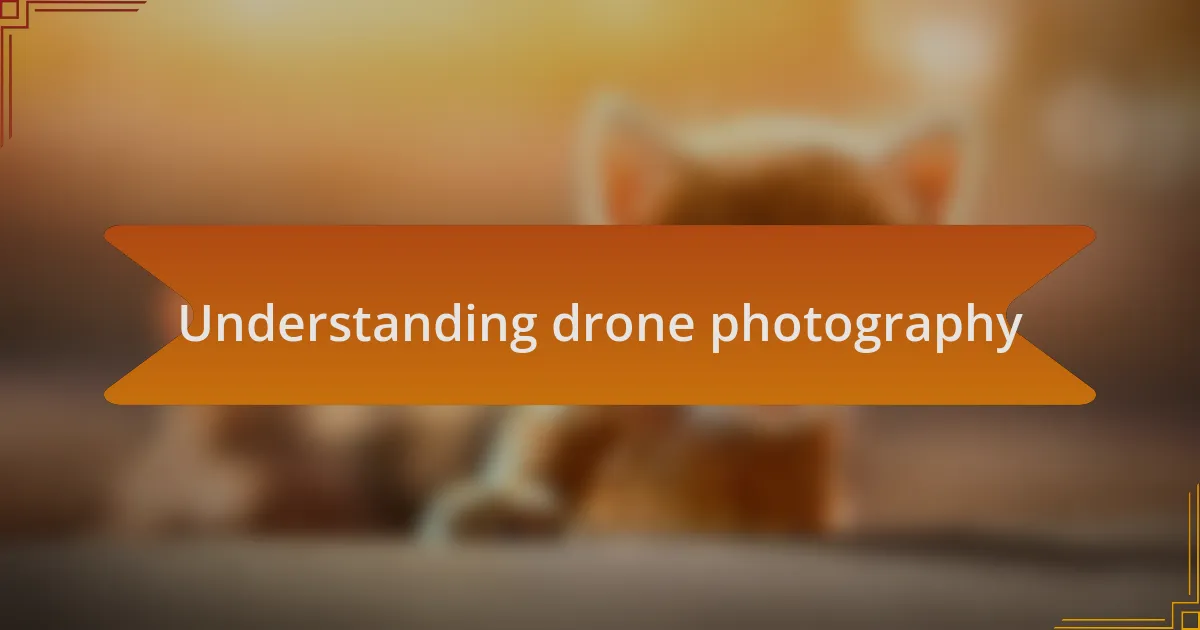
Understanding drone photography
Drone photography offers a unique perspective that traditional photography simply can’t capture. I remember my first time piloting a drone over the stunning coastline of Zanzibar – the view was breathtaking, and it felt like I had stepped into a whole new world. Have you ever looked out over a landscape and wished you could see it from above? With a drone, that wish becomes a reality, showcasing intricate patterns and details that would otherwise go unnoticed.
The technology behind drone photography is fascinating, as it combines advanced optics with the ability to soar above and around obstacles. I once flew my drone through a narrow valley and captured images that revealed hidden waterfalls and lush greenery. It’s incredible how a simple device can reveal the beauty of nature from angles that seem almost magical.
Additionally, mastering drone photography involves understanding the interplay of light, composition, and motion. I’ve had moments where the lighting was just right, transforming an ordinary scene into a captivating image. Have you ever felt that thrill when everything clicks into place? Getting the shot is more than just pressing a button; it’s about anticipating the perfect moment and knowing when to capture it.
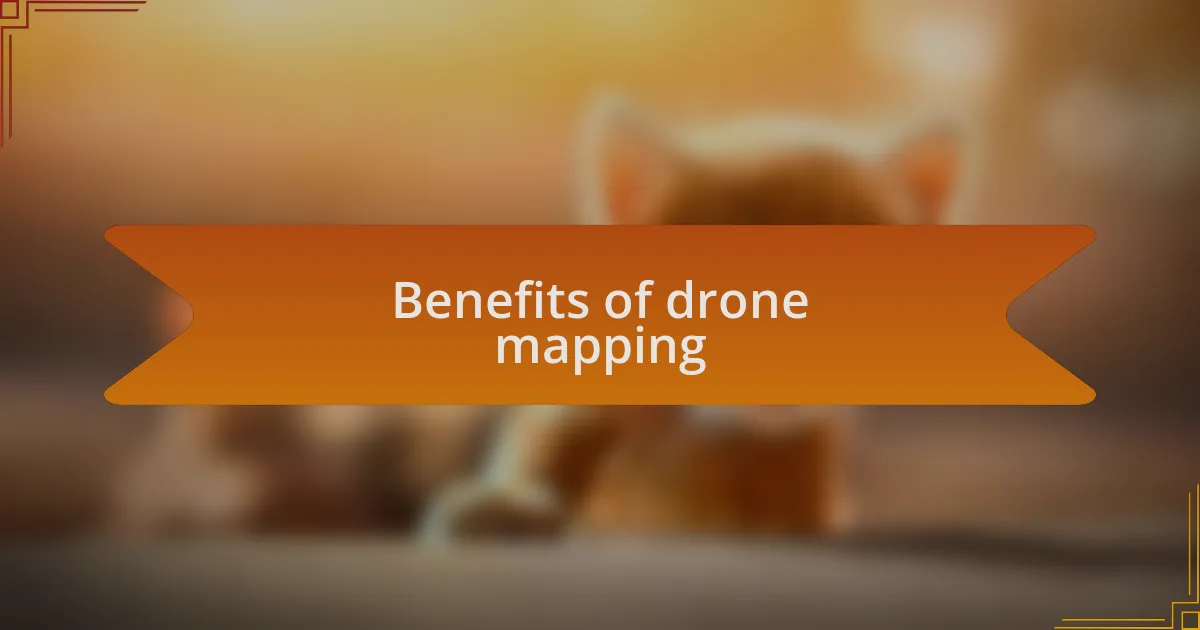
Benefits of drone mapping
When it comes to drone mapping, the benefits are numerous and significant. One major advantage is the ability to gather high-resolution data that can cover large areas in a fraction of the time it would take through traditional methods. I remember collaborating on a project in Zanzibar, where drone mapping allowed us to create detailed topographical maps quickly. It was exciting to see how efficiently we could analyze the terrain compared to labor-intensive processes.
Another benefit that stands out to me is the enhanced accuracy that drone mapping provides. Drones equipped with precise GPS technology can capture coordinate data with incredible accuracy, which is vital for tasks like land surveying. While working on a restoration project for the local coastline, we were able to identify specific erosion patterns more accurately than ever before, showcasing how drones can be invaluable in environmental monitoring.
Additionally, drone mapping opens up new avenues for creative expression and storytelling. I often think back to the time I used drone imagery to document changes in a beloved local beach. By overlaying different time-lapse maps, we could illustrate shifts in the landscape visually and effortlessly. Have you ever considered how powerful a visual narrative can be? It’s a way to connect with the community and share vital information about our environment in an impactful, engaging manner.
Overview of Zanzibar’s landscapes
Zanzibar’s landscapes are a stunning blend of vibrant colors and textures that can captivate any viewer. The island boasts lush green plantations, pristine white-sand beaches, and a dynamic coastline that features crystal-clear waters. I remember my first reaction when I flew my drone over the Jozani Forest; the rich tapestry of greenery was not just beautiful, but it also felt alive, an ecosystem teeming with biodiversity.
As I soared above the coastline, the stark contrast between the deep blues of the ocean and the bright sandy beaches struck me profoundly. It’s hard to convey the emotions of that moment; I felt an overwhelming sense of connection to this unique environment and gratitude for being able to witness it from such a breathtaking perspective. Have you ever experienced something that made you see the world through a different lens? Drone photography can do just that.
The varied topography of Zanzibar, which ranges from rolling hills to vibrant coral reefs, makes it an exceptional subject for both mapping and photography. I recall the delight I felt when capturing the iconic Stone Town from above—the intricate patterns of the buildings and winding streets revealed a history that words alone could not convey. Each flight offered new perspectives, and I found myself falling deeper in love with the landscape layered in richness and diversity.
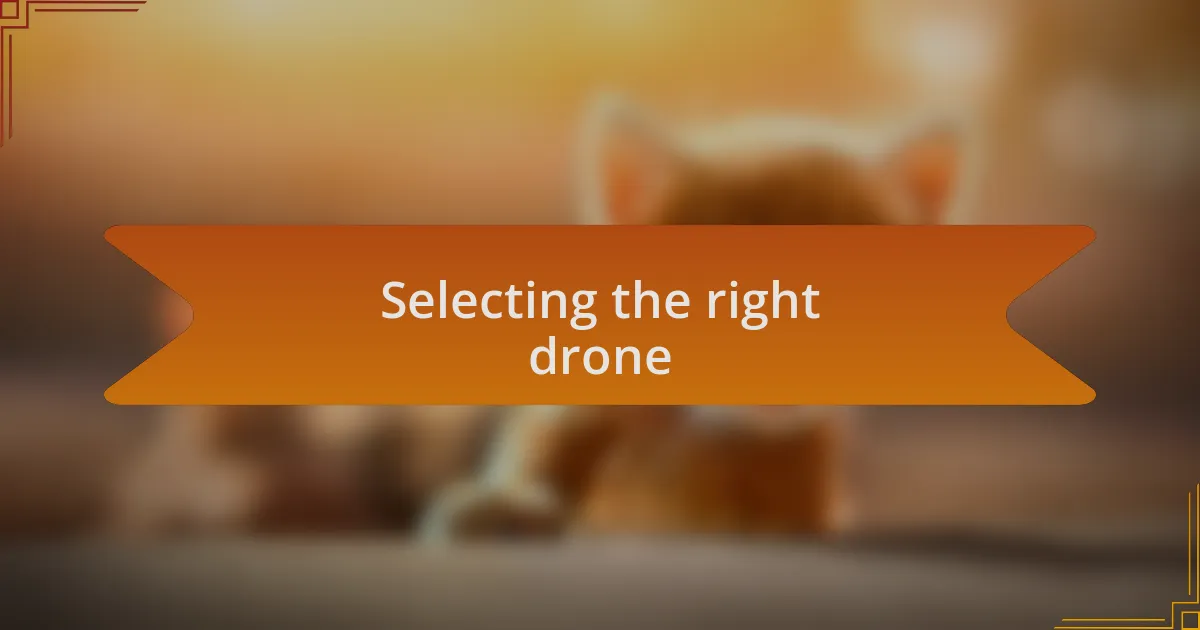
Selecting the right drone
When it comes to selecting the right drone for photography in Zanzibar, I’ve found that understanding the specific features of each model is crucial. For instance, if you’re aiming for high-resolution images, look for drones equipped with quality cameras that offer at least 12 megapixels. On one of my trips, I opted for a drone with a 4K camera, and the clarity of the images I captured was simply breathtaking, allowing me to see even the smallest details of the landscape.
Battery life is another significant factor to consider. During one particular shoot along the coastline, my drone’s battery lasted longer than expected, which allowed me to capture the breathtaking sunset in its full glory. I can’t help but wonder—how much more could I have captured if I’d chosen a drone with an even longer battery life? These moments reinforce the importance of doing your homework before making a purchase.
Lastly, I highly recommend considering the weight and portability of the drone. The lightweight model I chose was incredibly easy to carry around as I explored Zanzibar’s diverse environments. Remember that the ease of transport can enhance your overall experience, letting you focus on the art of capturing stunning visuals rather than worrying about hauling heavy gear. What’s your priority when selecting a drone? It’s essential to align your choice with your specific photography goals.
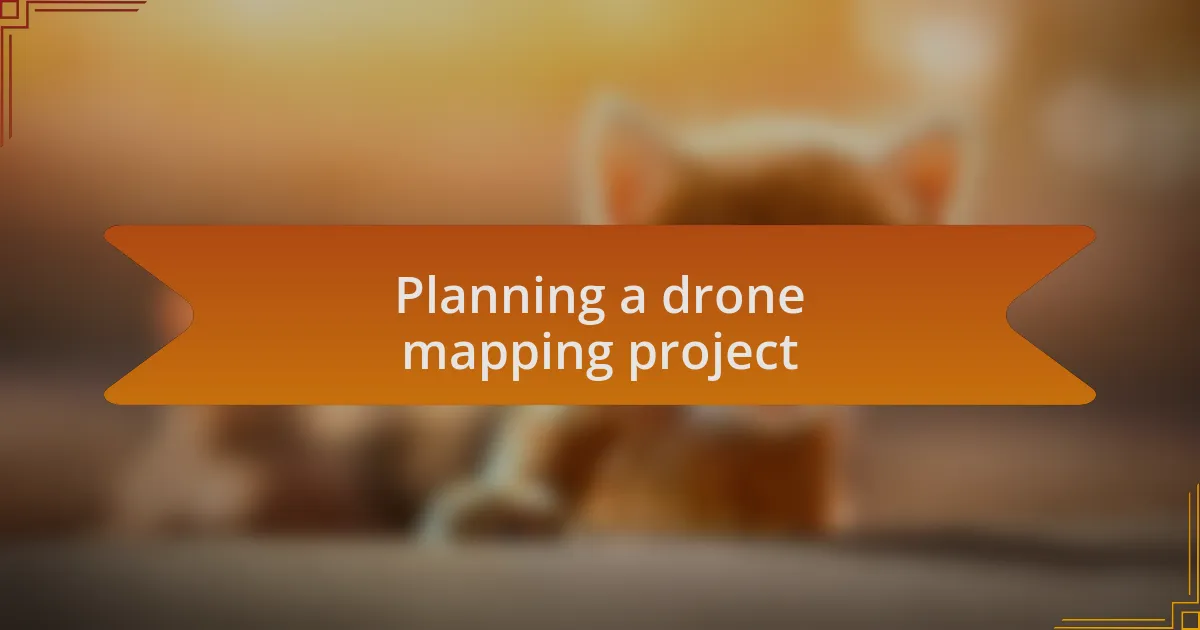
Planning a drone mapping project
Planning a drone mapping project requires careful consideration of the area you want to cover. I remember when I mapped a section of Paje Beach; it was essential to scout the location beforehand. Understanding the terrain and potential obstacles made it easier to decide on the optimal flight path, ultimately saving me time and ensuring I didn’t miss any crucial shots.
Timing plays a pivotal role in the success of your mapping project. On one occasion, I scheduled a flight for early morning to catch the soft light of dawn, and it made all the difference. Have you ever wondered how the time of day affects the quality of your images? The gentle sunlight not only enhanced the colors of the scenery but also provided a distinct atmosphere that later influenced the overall tone of my project.
Finally, working with local regulations is crucial. Before heading out for a mapping project, I always double-check the rules governing drone operations in the area. Once, I was caught off guard by a temporary flight restriction near Stone Town. It taught me a valuable lesson in the importance of thorough research and preparation—certain rules can catch even the most experienced pilot by surprise. So, have you looked into the regulations for your area? It’s an aspect that can greatly affect your plans and outcomes.
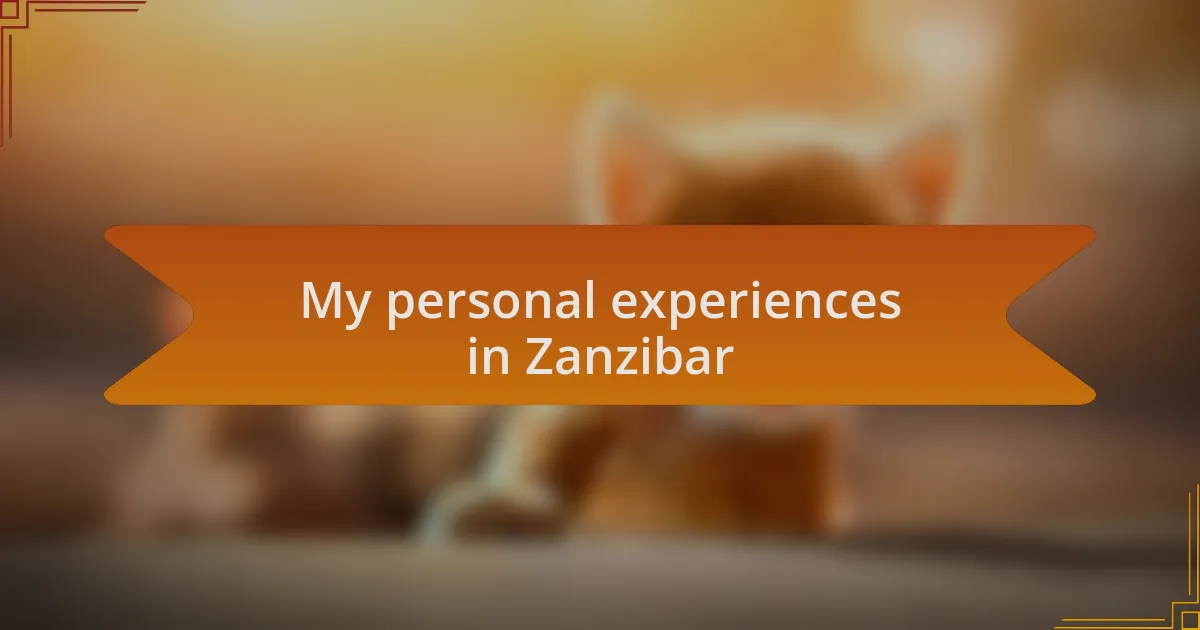
My personal experiences in Zanzibar
My time in Zanzibar was filled with breathtaking moments that I can still vividly recall. One afternoon, while flying my drone over the stunning waters of Nungwi, I felt an overwhelming sense of freedom and wonder. The crisp blue contrasted beautifully with the white sand beneath, and I found myself lost in the joy of capturing it all. Have you ever felt that rush when you know you’ve clicked a perfect shot?
Exploring the local culture brought another layer to my experiences. I remember flying my drone near a bustling market in Zanzibar City, where vibrant colors and lively interactions unfolded. The laughter of locals and the aroma of spices filled the air, making it hard to concentrate on piloting. I often wonder: how can a simple image convey the spirit of a place? In that moment, I realized that my photography could tell a story beyond just the visuals.
The sunsets in Zanzibar left me speechless time and again. I distinctively remember one evening perched on a cliff, where I waited for the sun to dip below the horizon. The golden hues painted the sky, and I felt a profound connection with nature. Capturing that moment from above, as the waves crashed against the rocks, was an experience that completely filled my heart with gratitude. Have you ever captured a scene that resonated so deeply within you? For me, it was a reminder that with every flight, I wasn’t just documenting a landscape but also collecting memories that would last a lifetime.
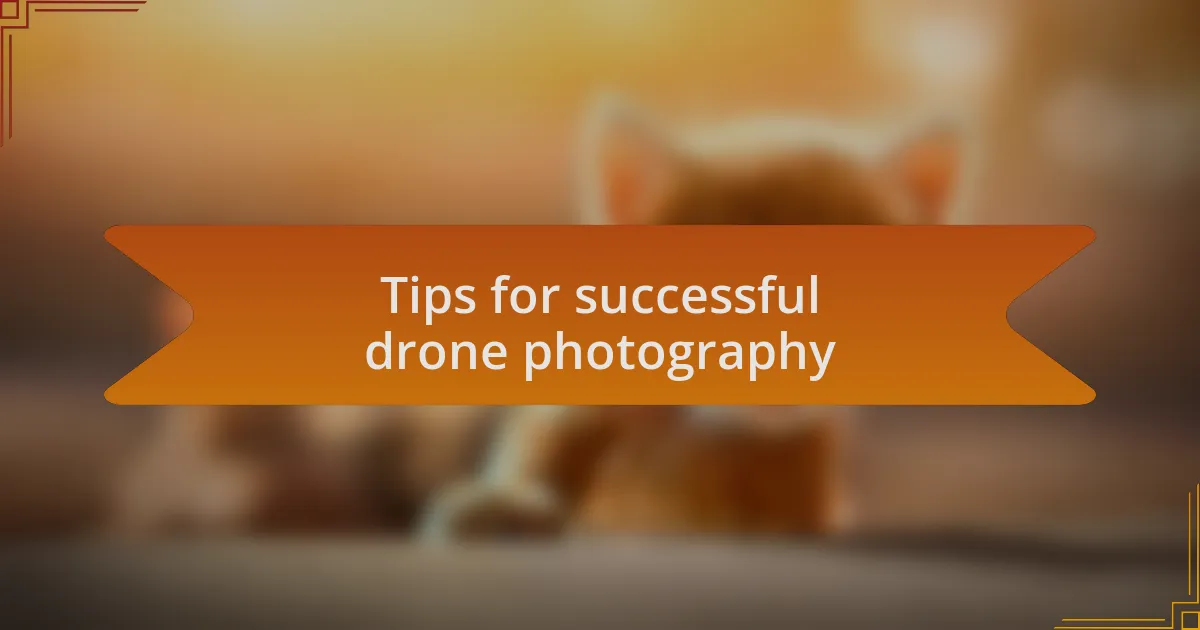
Tips for successful drone photography
Choosing the right time of day can make all the difference in your drone photography. I often find that early morning or late afternoon offers the perfect lighting—soft and warm—creating a magical atmosphere. Have you ever considered how shadows and highlights can transform a simple scene into something extraordinary? I certainly have, and it’s a game changer.
Another tip I swear by is planning your shots in advance. I remember mapping out specific areas in Zanzibar that I wanted to capture, which saved me from aimlessly flying around. It allowed me to focus on unique perspectives that would reflect the essence of the landscape. How do you ensure you capture everything you envisioned?
Lastly, I can’t stress enough the importance of understanding your drone’s capabilities. I took some time to learn about settings like shutter speed and frame rate, which really elevated my work. It’s thrilling to explore the intricacies of my device, don’t you think? The more I learned, the more confident I became in capturing stunning images that truly reflected my experience.